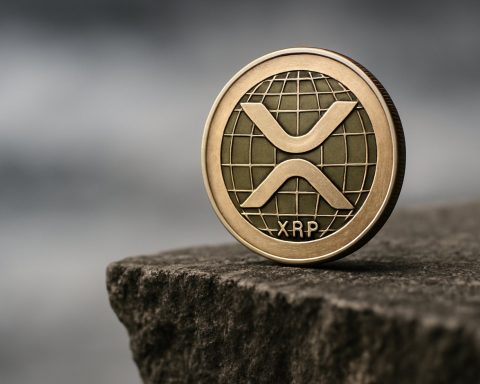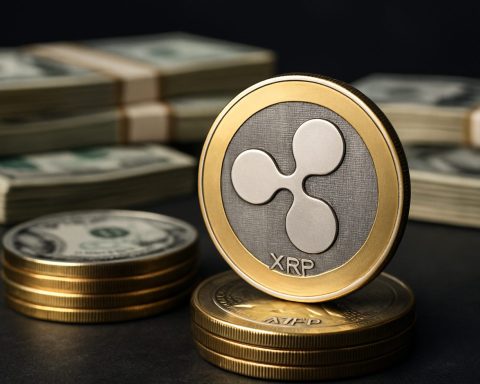- Pi Coin’s value has experienced significant volatility, dropping from $2.98 to $1.41, with a market cap of $10.18 billion.
- The critical KYC and migration deadline for Pi Network is March 14, 2025, impacting its long-term viability.
- Potential listing on Binance could drastically affect Pi Coin’s future price and adoption.
- Market fluctuations reflect broader crypto trends, with Pi facing uncertainty alongside Bitcoin’s challenges.
- Lightchain AI emerges as a competitor, integrating blockchain with AI, raising over $17 million in its presale.
- Investors view both Pi and Lightchain AI as high-risk but potentially lucrative opportunities in the crypto market.
- Successful crypto ventures require innovation and adaptability in a rapidly changing environment.
Crypto enthusiasts find themselves on the edge of their seats, watching Pi Coin’s wild price swings akin to the dizzying heights and plunges of a rollercoaster. Just weeks after taking center stage on CoinMarketCap, Pi Coin has seen its value cascade from a peak of $2.98 to a more modest $1.41, an impressive feat yet exhausted by volatility. With its market cap poised at $10.18 billion, all eyes are on Pi as it races to stabilize amid a cascade of market events—events that could set the stage for an industry-wide shakeup.
Pi Network’s promise has always been tantalizing: a community-driven digital currency that empowers anyone with a smartphone to become a miner. Yet, this dream teeters on a precarious edge as its pivotal KYC and migration deadline on March 14, 2025—marking the project’s sixth anniversary—draws nearer. This deadline could very well be a tipping point, either bolstering Pi’s place in the cryptocurrency pantheon or leading to upheaval among its investors. Delays have plagued the project, casting doubt on its long-term viability and urging Pi holders to make a decisive leap into compliance—or face forfeiting their coin balances forever.
Hope and skepticism dance around Pi’s potential listing on Binance, the world’s largest cryptocurrency exchange—a move that could either ignite Pi Coin’s resurgence or leave it languishing in uncertainty. Despite an overwhelming community vote in favor of such a development, Binance remains enigmatically silent. Industry watchers speculate whether this decision could potentially restore prices to their former glory, with some analysts bullish enough to predict levels as high as $30-$70 by year’s end, contingent upon significant exchange listings and widespread adoption. Others caution that a deluge of mined Pi coins could send prices plummeting below $1 if supply outpaces demand.
Amid Pi’s journey, the digital currency landscape itself has not remained static. Recent tremors in the broader crypto market—including Bitcoin’s own struggles—mirror the uncertainty shaking Pi. These fluctuations coincide with geopolitical developments like the U.S. Crypto Reserve spearheaded by former President Donald Trump, yet investors are apprehensive, fearing more questions than answers.
As Pi grapples with its own destiny, another player emerges: Lightchain AI. This project boldly integrates blockchain with artificial intelligence, capturing the curiosity of both developers and investors alike. With over $17 million raised in its presale phase, Lightchain AI stands as a testament to innovation in the crypto arena, offering a decentralized ecosystem that combines blockchain scalability with AI efficiency.
For those eyeing the crypto horizon, Lightchain AI represents another tantalizing opportunity, much akin to the early days of Pi. Yet, potential investors remain wary, knowing full well the path is fraught with both immense opportunity and significant risk. As history has consistently shown, strategic early entry coupled with a disciplined long-term perspective can prove lucrative.
In the ever-evolving saga of cryptocurrencies, Pi Coin remains a focal point, teetering between potentially explosive growth and cautionary tale. The stakes are high, and the outcomes uncertain—will a Binance listing or the decisive March deadline breathe new life into Pi? Meanwhile, Lightchain AI beckons as a fresh frontier in the crypto ecosystem, embodying the blend of cutting-edge technology and bold ambition. The search for the next big crypto success story continues, and in this fast-paced arena, one undeniable truth prevails: innovation and adaptability are the keys to survival and triumph.
Why Pi Coin’s Future Hinges on Key Developments and Emerging Competitors
Current State and Future Prospects of Pi Coin
The cryptocurrency market is no stranger to volatility, but Pi Coin’s recent price fluctuations have caught the attention of many. Despite its current market cap of $10.18 billion, Pi Coin faces a critical juncture due to the impending KYC and migration deadline on March 14, 2025. Success will require overcoming several hurdles, including potential listing on major exchanges like Binance and meeting compliance obligations.
Key Challenges for Pi Coin
1. KYC Compliance and Migration Deadline:
– Pi Network’s upcoming deadline is crucial. Users must complete the KYC process to secure their coin balances or risk forfeiture.
– The outcome of this compliance effort will significantly impact Pi’s credibility and user retention.
2. Potential Binance Listing:
– A listing on Binance could serve as a significant catalyst for Pi Coin, potentially stabilizing prices and attracting a wider investor base.
– The community’s strong preference for a Binance listing contrasts with the lack of official announcements, raising speculation about Pi’s legitimacy and future.
3. Volatility and Market Perception:
– The crypto market’s inherent volatility, mirrored by Pi’s fluctuating prices, underscores the need for careful consideration before investment.
Lightchain AI: A Fresh Contender
As Pi Coin navigates its challenges, Lightchain AI emerges as a compelling alternative in the crypto space. By integrating blockchain with AI, Lightchain AI offers a promising avenue for innovation, bringing efficiency and scalability to decentralized ecosystems.
Advantages of Lightchain AI
– Technological Integration: The seamless blend of AI and blockchain positions Lightchain AI as a forward-thinking project capable of addressing scalability issues assailing other cryptocurrencies.
– Investment Potential: With over $17 million raised in a successful presale, Lightchain AI has demonstrated strong investor interest, setting the stage for potential growth.
Real-World Use Cases and Trends
Pi Coin’s promise of enabling smartphone-based mining democratizes cryptocurrency access. However, this model comes with risks, including potential oversupply if mining outpaces demand. Conversely, Lightchain AI’s emphasis on AI blockchain integration opens new possibilities for decentralized applications and industries seeking efficient, scalable solutions.
Market Forecasts and Industry Trends
The broader cryptocurrency market’s reliance on speculative investments and its sensitivity to regulatory developments suggest a cautious approach. Analysts predict that Pi Coin could reach $30-$70 by the end of the year if listed on major exchanges with accelerated adoption. However, excess supply could drive prices below $1.
Actionable Recommendations
1. Complete KYC Early: For Pi users, ensuring KYC compliance before the March deadline can safeguard your assets and increase network trust.
2. Diversify Investments: Consider exploring alternatives like Lightchain AI to hedge against market volatility.
3. Stay Informed: Monitor regulatory developments and major exchange announcements to gauge investment opportunities.
Conclusion
In the ever-evolving cryptocurrency landscape, innovation and adaptability remain vital. Whether Pi Coin capitalizes on its community’s enthusiasm or whether projects like Lightchain AI chart new paths, the key to success will lie in strategic adaptability and informed investments. Keep track of developments in cryptocurrency projects at CoinMarketCap.













